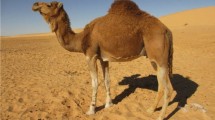Abstract
The change in the composition of camel milk in four dromedaries was studied by including the common measured parameters: protein, total fat, lactose, main minerals (calcium, phosphorus, and iron), and vitamin C. The fat matter varied from 4.34% to 7.81% with a slight decrease all along the lactation and a minimal value at the 14th week corresponding to the lactation peak. Those variations were less important for protein content (from 2.58% to 3.64%), but the minimal value was observed at the 14th week also. The lactose varied slightly around its mean of 3.46%. The vitamin C concentration varied from 48 to 256 mg/l with a tendency of increasing all along the lactation. Calcium and phosphorus concentrations were quite parallel and their ratio Ca/P was constant. The minimal values (1.43 g/l for calcium and 1.16 g/l for phosphorus) were observed at the beginning of the lactation. The iron concentrations varied around the mean of 1.73 mg/l.





Similar content being viewed by others
References
Abdelrahim, A.G., 1987. The chemical composition and nutritional value of camel (Camelus dromedarius) and goat (Capra hircus) milk. World Rev. Anim. Prod., 18, 9–12
Bachmann, M.R., Schultness, W., 1987. Lactation of camels and composition of camel milk in Kenya. Milchwissenschaft, 42 (12), 766–768
Bengoumi, M., Faye, B., Tressol, J.C., 1998. Composition minérale du lait de chamelle du sud marocain. Pages 145–149 in Actes de l’atelier “Chameaux et dromadaires, animaux laitiers”, Nouakchott, Mauritania, Oct. 24–26, 1994, P. Bonnet, ed. CIRAD Publ., Montpellier, France
Dabrowski K., Hinterleitner, S., 1989. Applications of a simultaneous assay of ascorbic acid, dehydroascorbic acid and ascorbic sulphate in biological materials, Analyst, 114, 83–87
Farah, Z., 1993 Composition and characteristics of camel milk, J. Dairy Res. 60, 603–626
Farah, Z., Rettenmaier, R., Atkins, D., 1992. Vitamin content of camel milk. Int. J. Vit. Nutr. Res., 62, 30–33
Faye, B., Konuspayeva, G., Messad, S., Loiseau, G., 2008. Discriminant milk components of Bactrian camel (Camelus bactrianus), dromedary (Camelus dromedarius) and hybrids. Dairy Sci. Technol., 88, 607–617
Feeley, R.M., Eitenmiller, R.R., Jones, J.B., Barnhart, H., 1983. Copper, iron and zinc contents of human milk at early stages of lactation. Am. J. Clin. Nutr., 37, 443–448
Ivachshenko, A., 2008. Plants from south-east of Kazakhstan [Tcvetkovye rasteniya yugo-vostoka Kazakhstana]. Association for the biodiversity conservation, Almaty, 184p
Konuspayeva, G., Faye, B., Loiseau, G., 2008a. The composition of camel milk: A meta-analysis of the literature data. J. Food Compos. Anal., 22, 95–101
Konuspayeva, G., Faye, B., Narmuratova, M., Meldebekova, A., Loiseau, G., 2008b. Variation factors of some minerals in camel milk. Proc. of . Intern. Workshop, “Impact of pollution on animal products”. Almaty (Kazakhstan), 27–30 September 2007, B. Faye and Y. Sinyavskiy (Eds), 125–133
Mal, G., Sena, D., Sahani, M.S., 2007. Changes in chemical and macro-minerals content of dromedary milk during lactation. J. Camel Pract. Res., 14, 195–197
Mehaia, M.A., Hablas, M.A., Abdel-Rahman, K.M., El-Mougy, S.A. 1995. Milk composition of Majeheim, Wadah and Hamra camels in Saudi Arabia. Food Chemist., 52, 115–122.
Mohamed, H.E., Mousa, H.M., Beynene, A.C., 2005. Ascorbic acid concentrations in milk from Sudanese camels. J. Anim. Physiol. Anim. Nutr., 89, 35-37
Richard, D., Gerard, D., 1985. La production laitière des dromadaires Dankali (Ethiopie). In: Conference internationale sur les productions animales en zones arides. 1985/09/07–12, Damas (Syrie), Maisons-Alfort, CIRAD-EMVT, 16 pp.
Sawaya, W.N., Khalil, J.K., Al-Shalhat, M., Al-Mohammed, H., 1984. Chemical composition and nutritional quality of camel milk. J. Food Sci., 49, 744–747
Wangoh, J., Farah, Z., Puhan, Z. 1998. Composition of milk from three camel (Camelus dromedarius) breeds in Kenya during lactation. Milchwissenschaft, 53 (3), 136–139.
Yagil, R., Etzion, Z., 1980. Effect of drought condition on the quality of camel milk. J. Dairy Res., 47, 159–166
Zhang, H., Yao, J., Zhao, D., Li, J., Guo, M., 2005. Changes in chemical composition of Alxa Bactrian camel milk during lactation. J. Dairy Sci., 88, 3402–3410
Author information
Authors and Affiliations
Corresponding author
Rights and permissions
About this article
Cite this article
Konuspayeva, G., Faye, B., Loiseau, G. et al. Physiological change in camel milk composition (Camelus dromedarius) 1. Effect of lactation stage. Trop Anim Health Prod 42, 495–499 (2010). https://doi.org/10.1007/s11250-009-9449-x
Received:
Accepted:
Published:
Issue Date:
DOI: https://doi.org/10.1007/s11250-009-9449-x




